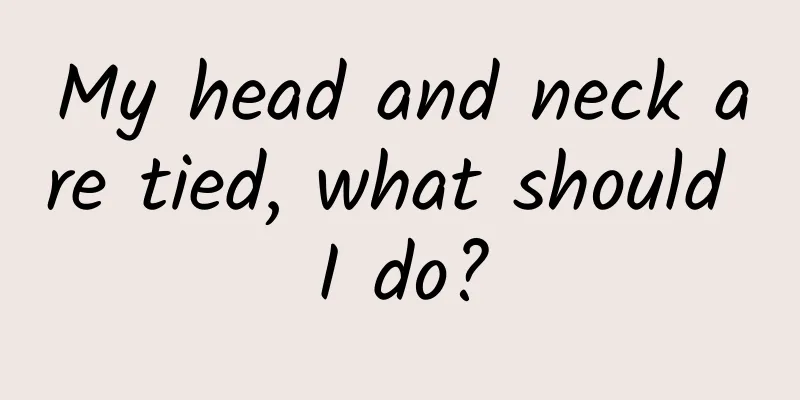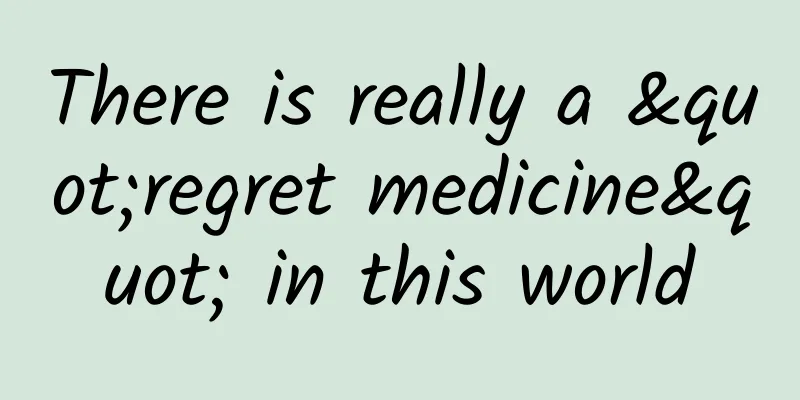My head and neck are tied, what should I do?

|
"The head and neck are not fixed" is a complaint that doctors in the rehabilitation medicine department often hear. At this point, I may need to explain to the majority of non-Shanghai friends what "fixed" means? In early 2020, Professor Zhang Wenhong made "fixed" popular all over the country. For a time, "fixed" became a synonym for perseverance and tenacity. "Fixed" is completely different. It refers more to a state of rigidity and stagnation. ——"Doctor, I was fine before I went to bed last night, but when I woke up this morning I found that I couldn't turn my head and neck. Please hold it tight." ——"Doctor, I was fine when I first started working, but after working for a few hours, my head and neck often feel uncomfortable and a little uncomfortable." Seeing this, you may suddenly realize that I have also had my head and neck “fixed” before. So… Why is the head and neck so “tight”? In fact, a "loose head and neck" is an external manifestation of acute injury or chronic fatigue injury to the neck, shoulder and back muscles. Acute injuries are mostly caused by reading on the bed before going to bed, using electronic devices, poor sleeping posture, or inappropriate pillows when sleeping, etc., which cause the head and neck muscles to be in a state of overstretching or flexion for a long time during sleep, causing excessive tension on one side of the neck muscles (levator scapulae, sternocleidomastoid, trapezius, etc.), or because the neck is in a fixed position for a long time, it suddenly turns and causes dislocation of the cervical facet joints, and eventually static injuries and contractures lead to unilateral stiffness and pain in the neck and limited movement. Therefore, when further inquiring about the medical history, it will be found that those patients who "were fine before going to bed last night" actually stayed up late to "move bricks" and play games before going to bed. Chronic fatigue injuries are mainly seen when workers maintain a single posture for a long time using electronic devices or working with their heads down. The "head-down tribe" bows their heads and works at desks day after day, making their neck, shoulder and back muscles (upper trapezius, levator scapulae, sternocleidomastoid and other inherent short muscles of the neck, etc.) become the main task of maintaining the head-down posture. Over time, the continuous tense contraction of muscles, shortened myometrium, increased tension and local ischemia will lead to cumulative fatigue injuries, which manifest as stiffness and pain in the neck and shoulders on one side or both sides at the same time. When the head and neck are extended or flexed, the levator scapulae (the blue part behind the neck in Figure 1) and trapezius (the blue part in Figure 2) are stretched and lengthened. If the head and neck are maintained in an extended position for a long time, the trapezius and levator scapulae muscles need to be continuously tense and contracted to maintain the extended position, which eventually causes accumulated strain and induces pain and tenderness points (Figures 1-4). The "dislocation" of the head and neck can heal itself, so you don't care at all? Many patients may have this idea that the head and neck are "stuck" from time to time, and it seems to heal slowly. But does the self-healing of the head and neck "stuck" mean that the neck and shoulder muscles are normal? In fact, it is not. The normal physiological activities, stability and dynamic balance of the cervical spine are achieved by maintaining appropriate tension through the coordination or antagonism of multiple groups of neck muscles. As mentioned earlier, long-term bowing and working at desks causes some neck, shoulder and back muscles to continue to contract and tense, increasing tension, thereby destroying the stability and dynamic balance of the cervical spine, and then affecting the stress of other spinal support structures such as ligaments and facet joints, accelerating their degeneration, and eventually even accelerating the degeneration of the cervical intervertebral disc. And this degeneration will accelerate the occurrence of cervical spondylosis. In short, the head and neck "stuck" is only an external manifestation, and the hidden internal problems such as muscle imbalance and cervical instability, if not handled in time, will lay the groundwork for the occurrence of various types of cervical spondylosis. In this case, my head and neck are “unsteady”, what should I do? The cervical spine is a key part that connects the upper and lower parts. Its stability comes from the balance of the soft tissues attached to it. Maintaining balance requires not only a certain strength of the soft tissues but also a certain flexibility. Patients with head and neck sprains have decreased neck muscle strength and muscle flexibility. Therefore, the treatment and prevention of head and neck sprains should also start from these two aspects: treat : First of all, when the head and neck are tied tightly, you can restore the flexibility of the tense muscles (such as the upper trapezius, levator scapulae, sternocleidomastoid, etc.) Upper trapezius stretch (taking the right side as an example): Sit or stand with your body straight, bend your neck to the left and slightly turn it to the right, gently support the side of your head with your left hand, and carefully stretch to the left. Stretch for 10-30 seconds each time, and repeat 3-4 times. Scapulae levator stretch (taking the right side as an example): Sit or stand, keep your body straight, turn your neck 45 degrees to the left, place your left hand behind your head, and carefully stretch toward the lower left front. Stretch for 10 to 30 seconds each time, and repeat 3 to 4 times. Sternocleidomastoid muscle stretching (taking the right side as an example): Sit or stand with your body straight, bend your neck to the left and tilt your head back, place your left hand on the right side of your head, and carefully stretch toward the left and back. Stretch for 10-30 seconds each time, and repeat 3-4 times. prevention: Of course, the improvement of muscle flexibility does not mean that we are free from head and neck injuries. It is more important to start from daily work and living habits and persist in exercise. 1. Cut off the inducement: avoid reading on the bed before going to bed, avoid using electronic devices for a long time before going to bed, avoid bending over the desk for a long time at work, and avoid using a pillow that is too high/too low (the recommended pillow height is 10-15cm). 2. Maintain the strength and flexibility of the neck muscles to avoid recurring head and neck sprains. ① Strengthen the deep muscles around the neck to restore cervical spine stability. Lie on your back/prone/side at one end of the treatment bed, with your head and neck suspended outside the bed, tuck your chin in, and stretch your head and neck toward the top of your head as much as possible. Hold for 10 seconds and then relax. Repeat 5-6 times. ② Correct bad posture through McKenzie training, restore the mechanical balance of the neck muscles and soft tissues in dynamic and static conditions, and relieve neck pain. Sitting retraction: Sit down, look straight ahead, relax completely, touch your chin with both hands and apply pressure backwards, so that the head and neck move slowly and steadily backward and upward to the maximum range, hold for 5-10 seconds, then relax to the initial position, repeat 5-6 times. Sitting retraction stretch and rotation: Sit down, stretch the head and neck to the maximum range based on the sitting retraction movement, repeat the head rotation 5-6 times (each time the tip of the nose rotates 1 cm from the middle to the left and right), then relax to the initial position, and repeat 5-6 times. ③ Strengthen cervical spine mobility training in daily life. Once you have mastered the simple and easy treatment methods mentioned above, you can start practicing them if you are troubled by head and neck stiffness! Of course, if neck pain and limited mobility do not ease for a long time, or are accompanied by other symptoms such as headache, dizziness, limb numbness and weakness, and unsteady walking, you need to go to the hospital for more professional and comprehensive evaluation and treatment. |
<<: Knee pain? Try this exercise rehabilitation
>>: There is a crackling sound in the cervical spine. Is there anything abnormal?
Recommend
Prevention of breast pain in women
In daily life, many female friends will have a pr...
Why are pregnant women's feet swollen and itchy?
Pregnancy is the most important stage in a woman’...
How to check for fallopian tube cancer
The fallopian tube is a very important part of th...
Which one makes you fatter, rice or noodles? Which one is healthier? 4 suggestions on staple foods!
Rice and noodles have a very high status on the d...
How many days is normal after menstruation?
Today's diet is becoming more and more divers...
Can I take rhinitis medicine during breastfeeding?
During the breastfeeding period, if rhinitis occu...
What to do if you get angry during confinement
Confinement is a process that every mother needs ...
Is it a boy or a girl if the skin becomes worse during pregnancy?
If the skin is worse, is it a boy or a girl? If t...
When does a girl's voice change?
As girls grow older, they will gradually enter pu...
If a couple is a carrier, there is a 1/4 chance that their child will be sick. The price of the SMA treatment drug, which costs 700,000 yuan per vial, has been reduced. How can this disease be prevented?
1. In the recent medical insurance negotiations, ...
The reason why there are a lot of blood clots in the aunt
As people pay more attention to their physical he...
What causes dysmenorrhea in women?
Dysmenorrhea is the most painful thing for girls....
The dog has tear stains. Is it caused by heat? How to remove tear stains for dogs?
As people's quality of life improves, more an...
I got my period the next day after using the gel
In our daily life, many patients need to use glue...









